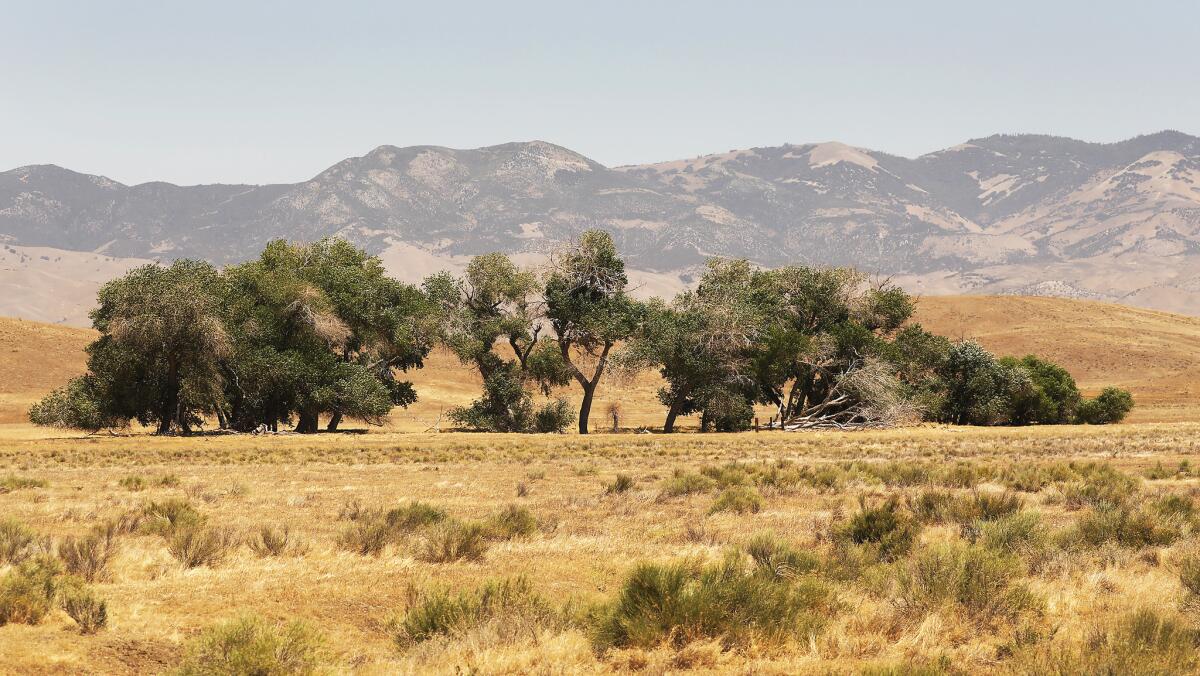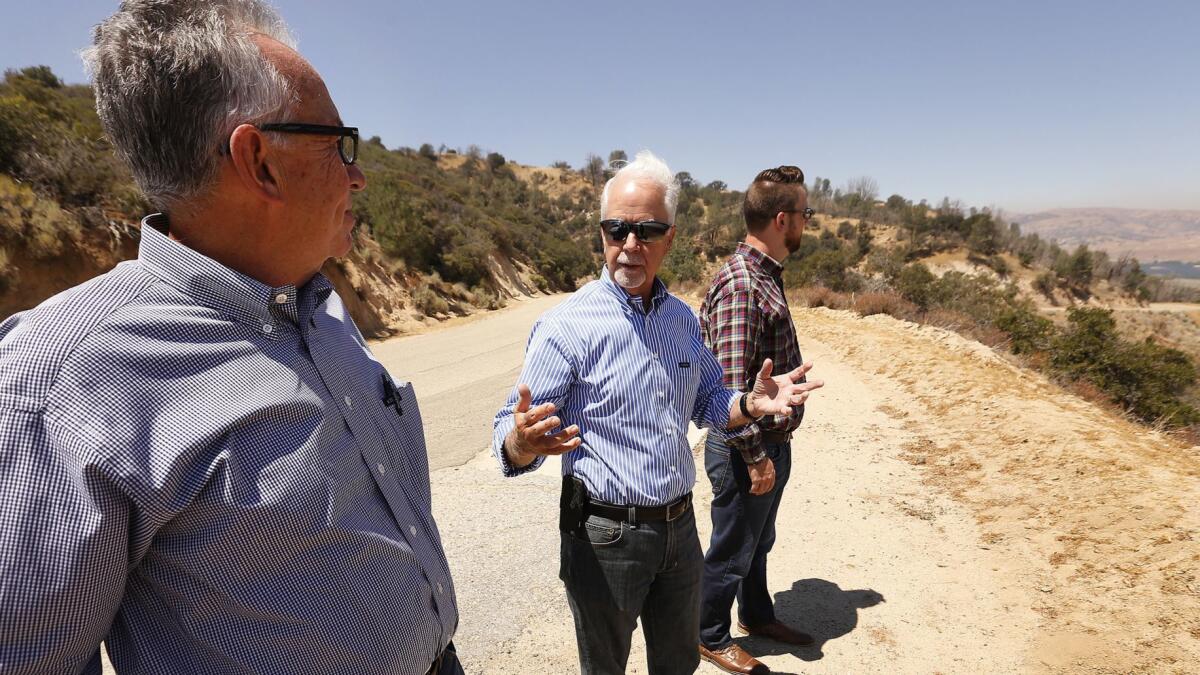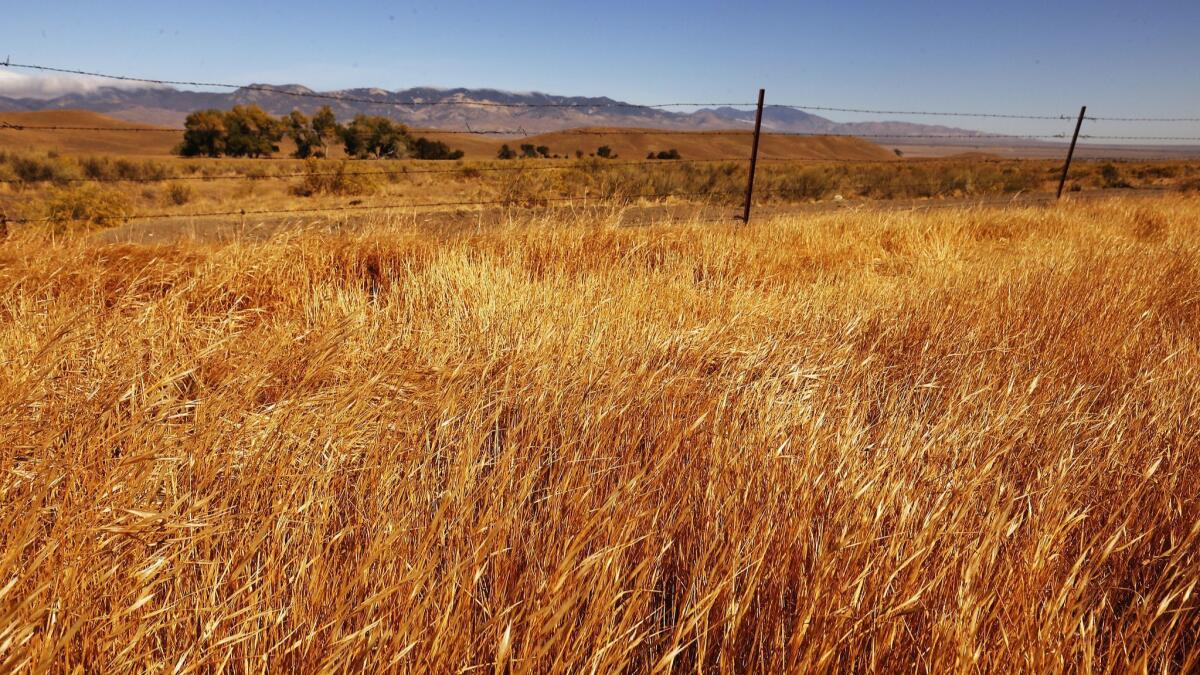L.A. County considers building a new city where fire hazard is high. Is Tejon Ranch worth the risk?

- Share via
A long-debated development in a remote, uninhabited part of Los Angeles County could be vulnerable to dangerous wildfires of the type California has seen in recent months, prompting concerns about the safety of building there.
The Centennial development at Tejon Ranch would sit squarely within “high” and “very high” fire hazard severity zones as defined by the California Department of Forestry and Fire Protection.
From 1964 to 2015, Cal Fire recorded 31 wildfires larger than 100 acres within five miles of Centennial, including four within the project’s boundaries, according to county planning documents.
Given those facts and the recent devastation of the Camp and Woolsey fires, some say the model that has long characterized development in Southern California — communities sprawling farther and farther out into wildland — is no longer sustainable.
“Going back to the 1960s, everywhere that we move … fire erupts,” said Char Miller, professor of environmental analysis at Pomona College.
“There’s a pattern here and we need to pay attention to the relationship between urban development on the one hand and wildland fire on the other,” Miller said.
Representatives for Tejon Ranch Co. said they have taken fire hazard into account and that modern building and safety practices can significantly reduce the risks.
“From the beginning of our planning process we’ve been cognizant of ‘fireproofing’ Centennial insomuch as any community can be fireproofed,” said Barry Zoeller, vice president of corporate communications and investor relations.
Over the last two years, California has experienced an unprecedented series of catastrophic wildfires, which burned tens of thousands of homes and killed more than 100 people. From Santa Rosa to Redding to Paradise, fires have swept into neighborhoods with incredible speed and destruction, generating new debate about the wisdom of building homes in areas that are susceptible to fire.
The disastrous toll of wildfires has also prompted discussion about how climate change has made homes in the path of fire more vulnerable than ever.
The proposed Centennial project, set to come before the Board of Supervisors on Dec. 11, would bring more than 19,000 homes to a private wilderness area. Supporters say it will help reduce California’s drastic housing shortage and provide more Californians the dream of a single-family home in a beautiful natural setting.
Aides to Supervisor Kathryn Barger, whose district includes the Centennial site, said she trusts the safety expertise of the L.A. County Fire Department, which submitted comments throughout the planning process and accepted the final environmental impact report.
Chris Perry, Barger’s planning deputy, said Centennial would bring four new fire stations to the community and provide multiple points of entry and exit.
“Every community has some vulnerability,” Perry said. “It’s one of the reasons we said you must have an overwhelming fire presence in any new community that you build.”

::
Like much of Southern California, Tejon Ranch experiences hot summer temperatures and a months-long dry season.
Though the area is susceptible to Santa Ana winds, more frequently it experiences cooler, moister winds from the north and northwest, lowering the potential for red flag conditions, said David Gomberg, manager of the fire weather program at the National Weather Service in Oxnard.
Local vegetation and terrain pose separate hazards.
The area selected for housing at Centennial is mostly flat grassland, though some of the site includes high brush, woodlands and steep slopes, increasing the chance of fire, according to county planning documents.
And grass, though short, is highly flammable.
“Add to that an ignition and you get a fire that’s burning very quickly,” said Alexandra Syphard, an ecologist at the Conservation Biology Institute.
The vast majority of wildfire ignitions result from human activity.
County planning staff and the Tejon Ranch Co. say fire risk at the project site can be contained.
Because Centennial falls within state-designated fire hazard zones, homes will be built according to the most stringent codes, requiring flame-resistant roofing, attic vents with mesh screens, and double-pane, tempered glass windows. Homeowners must also clear brush within a certain radius on their properties.
Because the community will be master planned, the developer can ensure all of its homes are built to the same specifications and surrounded by fire-resistant landscaping and open space — a luxury non-planned communities don’t have.
Power lines to the site — a frequent cause of fires — will be underground.
“You could get a series of fires in downtown L.A.,” said Zoeller, of Tejon Ranch Co. “What you have to do is … everything that you can within reason to try to fireproof any community anywhere.”
But fire experts say reducing the risk to zero isn’t realistic.
“The aesthetic that would be required to do that” — lots of concrete, small windows, little to no landscaping — “is something people don’t want,” said Michele Steinberg of the National Fire Protection Assn.
In fact, one attraction of Tejon Ranch is its natural environment, which the company has promised to preserve.
Even if all the houses are designed exactly to code, Steinberg said, they have to be maintained perfectly, with no dry leaves accumulating in gutters, cracks seeping between tiles or wooden decks tacked onto houses.
“We’re talking about fires spreading house to house, vegetation to house, embers to house …. The embers will get into gutters, ducts [and] vents that are open,” she said.
Once houses ignite, they radiate heat and drive the fire forward.
Coffey Park in Santa Rosa was destroyed this way, as the Tubbs fire raced from home to home. Aerial photos of Paradise show trees still standing between burned-out houses.
In a worst-case scenario, 60,000 people — double the population of Paradise — would have to evacuate Centennial at once.
”If the fire goes through fast enough, even with appropriate evacuation access, it becomes a human life concern,” Syphard said.
State Route 138, which leads to Interstate 5 to the west and State Route 14 to the east, would offer the main path in and out.
The two-lane highway will be expanded to four to six lanes, and the Tejon Ranch Co. says it will add connecting roads to facilitate traffic to and from Centennial.
But the company is not required to design an evacuation plan before the project’s approval. That will come later, with tract maps.

::
The county’s Regional Planning Commission has recommended approval of Centennial. Planning staff found that measures to lessen the project’s environmental impacts, including fire hazard, were adequate.
Mitch Glaser, an assistant administrator at the planning department, said public safety, health and welfare form the basis for all land-use planning at the county, but that there is no specific regulation prohibiting development in a fire hazard zone.
The Board of Supervisors could still deny the Centennial project on that or another basis, he said, but would need to explain its decision.
Glaser said he was not aware of any development in L.A. County that had been rejected wholesale because of fire hazard, though at least one had been downsized because of it.
Los Angeles is not unusual. Research shows that across California and the U.S., the number of homes built in wildland areas, including those that have previously burned, is growing.
The legal ground for denying developers the right to build after they’ve met local planning requirements is shaky, said Don Elliott, director of the land-use consultancy Clarion Associates.
The 5th Amendment enshrines private property rights, and governments can be sued for taking private land and leaving the owner with no “reasonable economic use” of it.
“The government will lose that lawsuit,” Elliott said.
“If you want to say you can’t build in a fire hazard area, you have to adopt a resolution or ordinance ahead of time,” he said. That law must be based on objective standards, including risk maps, and go through a public approval process.
The federal government already gives states and municipalities incentives to regulate developments in flood plains this way, but no parallel system exists for developments in the wildland-urban interface.
Donald Falk, a fire researcher at the University of Arizona, said communities should proceed carefully.
“We need new places to live, of course, but we have to recognize that every time we build a house in an area that is fire-prone we are just making the land-use problem more difficult,” he said. “We can’t be surprised down the road when we’re spending billions of dollars and losing many lives as a consequence of those decisions.”
Twitter: @AgrawalNina
More to Read
Sign up for Essential California
The most important California stories and recommendations in your inbox every morning.
You may occasionally receive promotional content from the Los Angeles Times.











